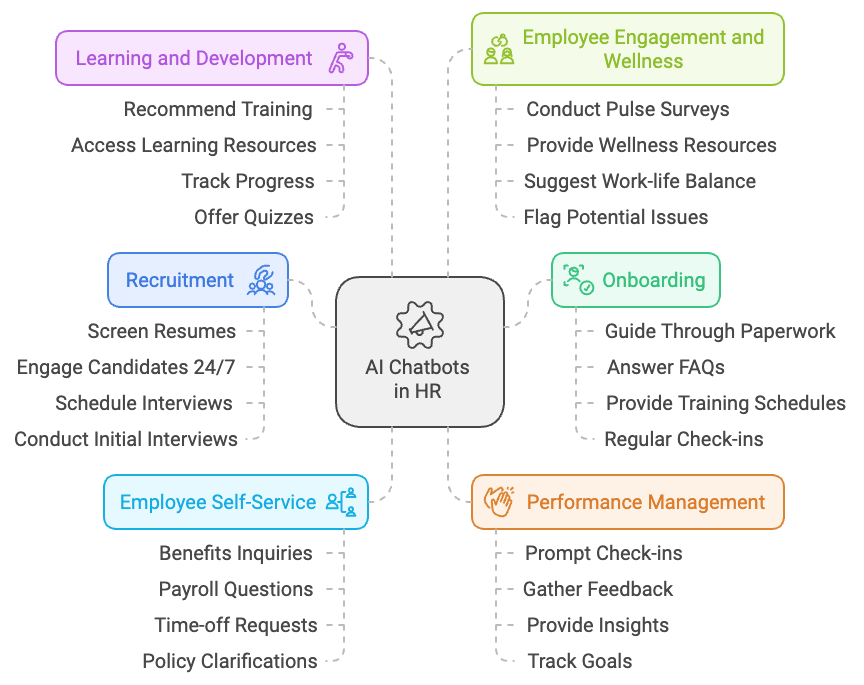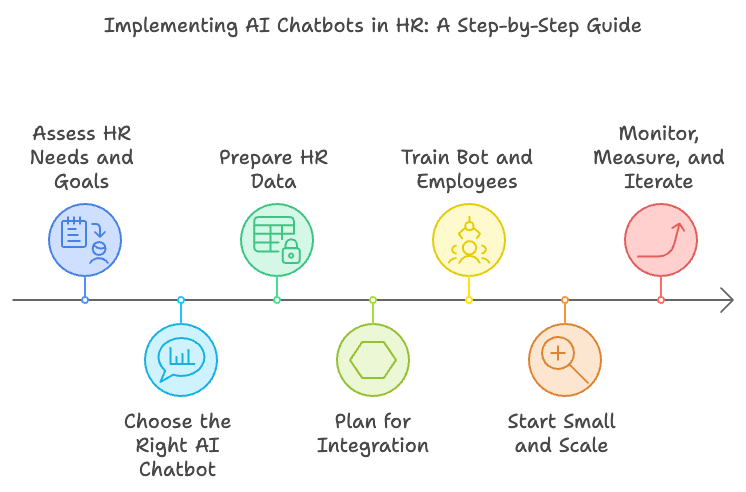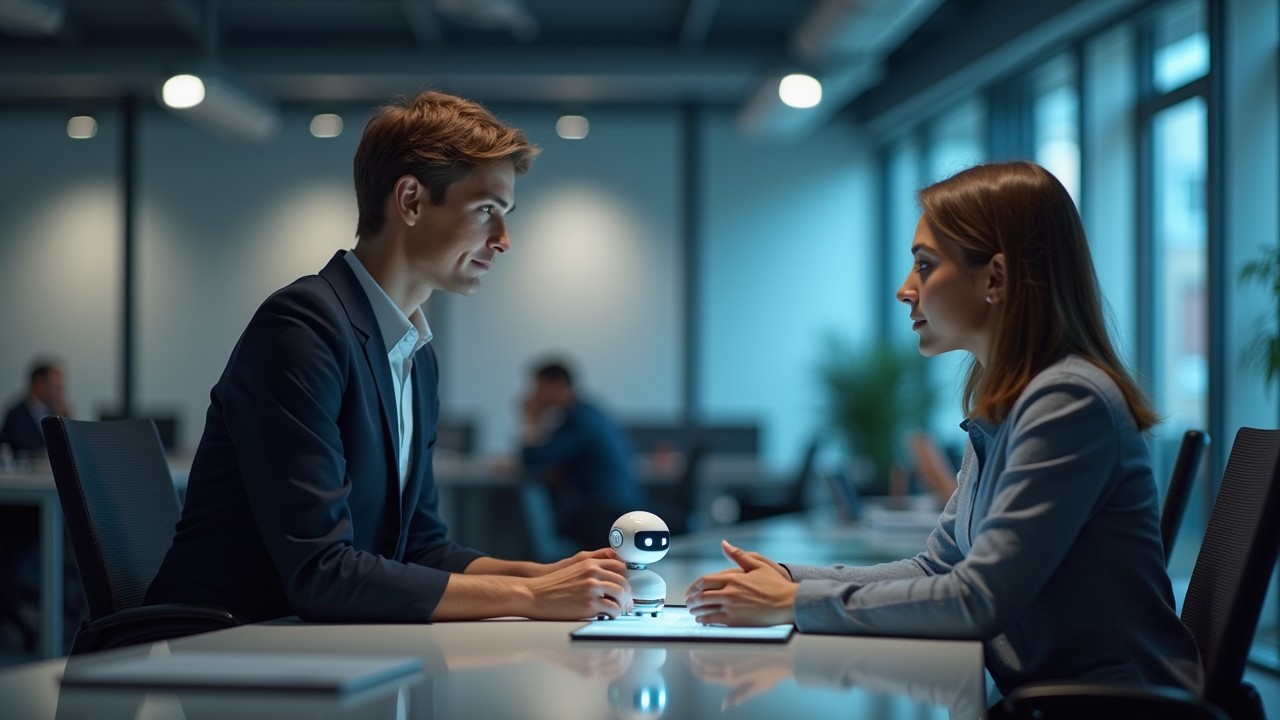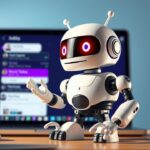Imagine you’re an HR professional, and your job is like being the air traffic controller for a bustling airport of human emotions, career aspirations, and corporate policies. Now, picture having a super-smart, tireless assistant who can handle a chunk of that air traffic for you, 24/7, without ever needing a coffee break or a vacation. That’s what AI chatbots are bringing to the HR world, and it’s about as game-changing as giving horses roller skates (except, you know, actually useful).
In this guide, we’re going to explore the wild and wonderful world of AI chatbots in HR. We’ll dissect their silicon brains, figure out how they’re transforming HR departments faster than you can say “Artificial Intelligence,” and even peer into the crystal ball to see what the future holds.
So, grab your favorite beverage, put on your thinking cap (maybe the one with the propeller), and let’s dive in!
What Are AI Chatbots, and Why Should HR Care?
The Basics: Not Your Grandma’s Chatbot
First things first: What exactly is an AI chatbot? Well, it’s not the clunky, frustrating experience you might remember from trying to get help with your internet connection in 2005. Today’s AI chatbots are like the Tesla of the digital assistant world – sleek, smart, and sometimes a little too eager to show off their capabilities.
At its core, an AI chatbot is a computer program designed to simulate human conversation. But these aren’t just glorified Magic 8 Balls spitting out pre-programmed responses. Modern AI chatbots use natural language processing (NLP) and machine learning algorithms to understand context, learn from interactions, and provide increasingly sophisticated responses.
Imagine if you could clone yourself, but your clone was really good at math, never forgot anything, and could work 24/7 without complaining. That’s essentially what an AI chatbot is for your HR department.
The HR Connection: Why Chatbots and HR are a Match Made in Silicon Heaven
Now, you might be thinking, “Okay, smart robots are cool and all, but what does this have to do with managing Karen from accounting’s vacation requests?” Well, my friend, the answer is: everything.
HR departments are like the Swiss Army knives of the corporate world. They handle everything from recruitment and onboarding to employee relations, benefits management, and making sure the office ficus plants don’t stage a revolt. It’s a lot of moving parts, and a lot of repetitive tasks that eat up valuable time.
Enter AI chatbots. These digital dynamos can take on a huge chunk of the routine queries and tasks that bog down HR professionals, freeing them up to focus on the more complex, human-centric aspects of their jobs. It’s like having a super-efficient personal assistant who never sleeps, never gets cranky, and always remembers your coffee order (even if it can’t actually make the coffee… yet).
The Superpowers of AI Chatbots in HR
Now that we’ve established what AI chatbots are and why HR should care, let’s dive into the nitty-gritty of what these digital wizards can actually do. Spoiler alert: it’s a lot.
Recruitment and Candidate Screening: The Ultimate Talent Matchmaker
Imagine if Tinder and LinkedIn had a baby, and that baby grew up to be really, really good at finding the perfect job candidates. That’s essentially what AI chatbots are doing for recruitment.
These bots can:
- Screen resumes faster than you can say “previous work experience”
- Engage with candidates 24/7, answering their questions about the job and company
- Schedule interviews without the back-and-forth email tennis match
- Even conduct initial interviews to assess basic qualifications and cultural fit
It’s like having a tireless recruiter who never needs to sleep, eat, or binge-watch Netflix. The result? A faster, more efficient hiring process that identifies top talent quicker than ever before.
Onboarding: From New Hire to Superstar in Record Time
Remember your first day at a new job? The overwhelming flood of information, the struggle to remember everyone’s names, the desperate search for the bathroom? AI chatbots are here to make that experience smoother than a freshly waxed bowling lane.
These digital onboarding assistants can:
- Guide new hires through paperwork and company policies
- Answer FAQs about benefits, company culture, and where to find the good snacks
- Provide personalized training schedules and resources
- Check in regularly to ensure new employees are settling in well
It’s like giving each new hire their own personal orientation guru, minus the awkward small talk and bad jokes (unless you program those in, of course).
Employee Self-Service: The 24/7 HR Helpdesk
Picture this: It’s 11 PM on a Sunday, and an employee suddenly remembers they need to change their health insurance beneficiary. In the old days, they’d have to wait until Monday morning, send an email, and hope for a response before they forget again. With AI chatbots, they can get it done before their midnight snack.
These always-on assistants can handle:
- Benefits inquiries and updates
- Payroll questions
- Time-off requests
- Policy clarifications
- And pretty much any other routine HR task you can think of
It’s like giving every employee their own personal HR representative, minus the awkward water cooler conversations about last night’s reality TV drama.
Performance Management: The Continuous Feedback Loop
Traditional performance reviews are about as popular as a root canal performed by an amateur juggler. AI chatbots are here to change that, making performance management an ongoing, painless process.
These digital coaches can:
- Prompt regular check-ins between managers and employees
- Gather continuous feedback from both sides
- Provide real-time performance insights and suggestions for improvement
- Track goals and progress throughout the year
It’s like having a friendly, non-judgmental mentor who’s always ready to offer advice and track your progress, without the awkward lunch meetings.
Learning and Development: Your Personal Career Sherpa
In today’s fast-paced work environment, continuous learning isn’t just a nice-to-have – it’s as essential as coffee on a Monday morning. AI chatbots are turning into the ultimate career development sidekicks.
These learning assistants can:
- Recommend personalized training based on an employee’s role, skills, and career goals
- Provide on-demand access to learning resources and microlearning modules
- Track progress and certifications
- Offer quizzes and knowledge checks to reinforce learning
It’s like having a super-smart friend who’s always pushing you to be your best self, minus the guilt trips and protein shake recommendations.
Employee Engagement and Wellness: The Digital Mood Ring
Happy employees are productive employees, and AI chatbots are becoming surprisingly good at keeping tabs on workforce morale. They’re like the mood rings of the corporate world, but actually accurate and useful.
These digital wellness gurus can:
- Conduct regular pulse surveys to gauge employee sentiment
- Provide resources for mental health and wellness
- Offer personalized suggestions for work-life balance
- Flag potential issues before they become full-blown problems
It’s like having a therapist, life coach, and cheerleader rolled into one, minus the hefty hourly rates and uncomfortable couch sessions.

The Challenges: It’s Not All Rainbows and Algorithms
Now, before you rush off to replace your entire HR department with an army of chatbots, let’s pump the brakes for a moment. Like any technology, AI chatbots come with their own set of challenges and limitations. It’s important to understand these before you go all-in on your robot HR revolution.
The Human Touch: Some Things Just Need a Flesh-and-Blood Human
While AI chatbots are getting scarily good at mimicking human conversation, they’re not quite ready to pass the Turing test in HR situations. Some aspects of HR, like handling sensitive employee issues or navigating complex interpersonal conflicts, still require the nuanced touch of a human professional.
Imagine trying to explain to a chatbot why you’re upset about Dave from marketing always microwaving fish in the office kitchen. The bot might suggest air fresheners, but it won’t understand the deep, psychological impact of persistent fish smell on workplace morale.
Data Privacy and Security: With Great Data Comes Great Responsibility
AI chatbots need data to function effectively, and in HR, that data is often sensitive employee information. Ensuring the security and privacy of this data is crucial, and it’s a challenge that keeps many HR tech professionals up at night (well, that and the endless stream of “Is this a phishing email?” questions).
It’s like giving a super-intelligent, always-curious teenager the keys to the family safe. Sure, they might be trustworthy, but you’re still going to want some serious safeguards in place.
Integration Headaches: Making Your Tech Play Nice Together
Implementing AI chatbots isn’t as simple as downloading an app. These systems need to integrate with your existing HR software, which can be about as easy as teaching a cat to bark. Ensuring smooth data flow and compatibility between systems is a challenge that requires careful planning and often a few aspirin.
The Learning Curve: Teaching Old Dogs New AI Tricks
While AI chatbots are designed to be user-friendly, there’s still a learning curve for both HR professionals and employees. Some people might be hesitant to trust a bot with their HR needs, while others might need time to adjust to this new way of interacting with HR.
It’s like introducing smartphones to a tribe that’s been using smoke signals. Sure, it’s more efficient, but there’s bound to be some confusion and resistance at first.
Keeping Up with the AI Joneses: The Never-Ending Tech Race
AI technology is evolving faster than fashion trends in the 60s. Keeping your chatbots up-to-date with the latest advancements can be a constant (and potentially costly) challenge. It’s like trying to keep up with teenage slang – just when you think you’ve got it figured out, everything changes.
The Future of AI Chatbots in HR: Crystal Ball Time
Now that we’ve covered the present state of AI chatbots in HR – both the good and the challenging – let’s strap on our futurist goggles and peer into what the future might hold. Spoiler alert: it’s looking pretty sci-fi in here.
Emotional Intelligence 2.0: Chatbots with Feelings (Sort of)
As AI continues to advance, we’re likely to see chatbots that are even better at understanding and responding to human emotions. They might not be shedding real tears anytime soon, but they could become sophisticated enough to detect subtle cues in language and respond with appropriate empathy.
Imagine a chatbot that can tell you’re having a rough day just from how you type your vacation request, and offers a friendly word of encouragement along with your approval. It’s like having a digital mom who always knows when you need a hug (but thankfully can’t actually hug you through the screen).
Predictive HR: The Crystal Ball Gets an Upgrade
Future AI chatbots might not just respond to queries – they could proactively identify potential issues before they arise. Using advanced analytics and machine learning, these bots could predict everything from which employees are at risk of leaving to potential conflicts in team dynamics.
It’s like having a psychic on your HR team, minus the crystal ball and mysterious smoke effects (although you could probably program those in for fun).
Virtual HR Assistants: Siri’s Cooler, More Helpful Cousin
As natural language processing continues to improve, we might see the rise of sophisticated virtual HR assistants. These could be voice-activated AI that can handle complex HR tasks through conversation, making the interaction even more natural and accessible.
Picture asking your office AI, “Hey HR-bot, can you help me understand my stock options?” and getting a clear, personalized explanation. It’s like having a really knowledgeable HR pro living in your smart speaker.
Augmented Reality Onboarding: Welcome to HR, Hologram Style
Combine AI chatbots with augmented reality, and you get a whole new onboarding experience. New hires could tour the office virtually, guided by an AI assistant that provides information about different departments and introduces them to holographic versions of their coworkers.
It’s like Pokemon Go, but instead of catching Pikachu, you’re learning about your company’s mission statement and where to find the good coffee machine.
The Ethics AI: Keeping Everyone on Their Best Behavior
As AI becomes more integrated into HR processes, we might see the development of specialized ethics AI that helps ensure fair and unbiased decision-making in areas like hiring and performance reviews.
These AI could act as impartial observers, flagging potential biases and ensuring compliance with ever-evolving employment laws. It’s like having a tiny, digital Supreme Court Justice living in your HR software.
Implementing AI Chatbots in HR: A Roadmap to Robot HR Bliss
So, you’re sold on the idea of bringing AI chatbots into your HR department. Great! But before you start naming your new digital employees, let’s talk about how to actually implement these tech marvels without causing a robot uprising (or, you know, just a lot of confusion and frustration).
Step 1: Assess Your Needs and Goals
Before you dive headfirst into the world of AI, take a step back and consider what you actually need. Are you looking to streamline recruitment? Improve employee self-service? Enhance your learning and development programs?
Make a list of your HR pain points and prioritize them. It’s like making a wishlist for Santa, except instead of toys, you’re asking for efficient HR processes (which, let’s be honest, can be just as exciting for HR pros).
Step 2: Choose Your Champion(s)
Not all AI chatbots are created equal. Some specialize in recruitment, others in employee engagement, and some try to do it all. Research different vendors and solutions to find the one that best fits your needs.
Consider factors like:
- Ease of integration with your existing systems
- Customization options
- Scalability
- Data security features
- Cost
It’s like dating, but instead of looking for someone who enjoys long walks on the beach, you’re looking for a bot that enjoys long sessions of answering benefits questions.
Step 3: Prepare Your Data
AI chatbots are only as good as the data they’re trained on. Before implementation, you’ll need to organize and clean your HR data. This might include:
- Digitizing paper records
- Standardizing data formats
- Ensuring data accuracy
- Identifying which data sources the chatbot will need access to
Think of it as Marie Kondo-ing your HR data. If it doesn’t spark joy (or provide useful information), it might be time to let it go.
Step 4: Plan for Integration
Work with your IT department to plan how the AI chatbot will integrate with your existing HR systems. This might involve:
- API integrations
- Data mapping
- Security protocols
- User authentication processes
It’s like introducing a new pet to your household – you need to make sure it plays nice with all your existing tech “pets.”
Step 5: Train Your Bot (and Your People)
Your AI chatbot will need initial training on your specific HR policies, procedures, and company culture. But remember, your human employees will need training too. Develop a change management plan that includes:
- Clear communication about the new technology
- Training sessions for HR staff and employees
- A feedback mechanism for continuous improvement
It’s like teaching a new language – to both the bot and your staff. Patience and practice are key.
Step 6: Start Small and Scale
Consider starting with a pilot program in one area of HR or with a small group of employees. This allows you to:
- Iron out any kinks in the system
- Gather user feedback
- Build confidence in the technology
Think of it as dipping your toe in the AI waters before diving in headfirst.
Step 7: Monitor, Measure, and Iterate
Once your chatbot is up and running, the work isn’t over. Regularly monitor its performance, measure its impact on your HR metrics, and gather user feedback. Use this information to continuously improve and expand the chatbot’s capabilities.
It’s like raising a child – your AI chatbot needs ongoing guidance and education to reach its full potential (but with less backtalk and hopefully no teenage rebellion phase).

ChatCube: The Magic Wand for HR Chatbot Creation
Alright, so we’ve talked about the what, why, and how of AI chatbots in HR. But if you’re sitting there thinking, “This sounds great and all, but I’m an HR professional, not a tech wizard. How am I supposed to actually do all this?” – fear not, my friend.
Enter ChatCube, the fairy godmother of chatbot creation.
Imagine if implementing an AI chatbot was as easy as making instant noodles. You know, just add water (or in this case, data), wait a couple of minutes, and voila! You’ve got yourself a fully functional, custom AI chatbot. That’s essentially what ChatCube does, minus the risk of burning your tongue on hot AI soup.
ChatCube is like the IKEA of chatbot creation – except instead of confusing Swedish instructions and missing screws, you get a no-code tool that takes you from “chatbot curious” to “chatbot curator” in less time than it takes to watch an episode of The Office.
Here’s how ChatCube turns the daunting 5-step process we discussed earlier into a walk in the park (or more accurately, a few clicks in an interface):
- Assess Your Needs and Goals: ChatCube says, “Why stop at one chatbot?” With this tool, you can create multiple custom ChatGPT-like chatbots for different aspects of your HR operations. Want a chatbot for onboarding? Click. Recruitment? Click. Answering “Is it okay to microwave fish in the office kitchen?” for the millionth time? Click, click, click.
- Choose Your Champion: With ChatCube, you’re not just choosing a champion; you’re creating one. It’s like Build-A-Bear, but instead of stuffing a teddy, you’re stuffing your chatbot with all your HR knowledge.
- Prepare Your Data: Remember when we talked about Marie Kondo-ing your HR data? ChatCube makes this process smoother than a freshly waxed floor. Just upload your internal docs, and ChatCube will digest them faster than your coworker inhales donuts on Free Pastry Friday.
- Plan for Integration: With ChatCube, integration is about as complicated as plugging in a toaster. It’s designed to play nice with your existing systems, no computer science degree required.
- Train Your Bot (and Your People): Here’s where ChatCube really shines. Training your bot is as easy as clicking a button. And when you create new content? One click, and your bot is up to date. It’s like having a student who actually reads all the course materials – and retains everything.
But wait, there’s more! (I’ve always wanted to say that in a non-infomercial context.)
ChatCube doesn’t just create any old chatbot. It creates a chatbot that’s like the love child of ChatGPT and your HR department. It can answer questions with the breadth of knowledge of ChatGPT, but with the specific expertise of your business. It’s like if you could shrink your entire HR team, along with all your company policies and procedures, into a friendly, tireless digital assistant.
And here’s the kicker – ChatCube knows its limits. When it’s unsure about something, it doesn’t just make stuff up like that one coworker who always has an “answer” for everything. Instead, it gracefully hands off to a human agent. It’s like having a really self-aware intern who knows when to call in the big guns.
The best part? Setting up your ChatCube-powered HR chatbot takes less time than your average coffee break. In under 5 minutes, you can have a custom chatbot up and running, ready to handle everything from customer support questions to lead generation. It’s so fast, you’ll find yourself with extra time on your hands – time you can spend on important HR tasks, like figuring out how to explain to Dave that yes, microwaving fish is still not okay, no matter how many times he asks the chatbot.
So, HR professionals of the world, rejoice! The future of HR chatbots isn’t just here – it’s here, it’s easy, and it’s named ChatCube. It’s time to take your HR department to infinity and beyond, or at least to “way more efficient than yesterday.” Your very own HR AI assistant awaits – no coding skills, magic wands, or sacrifices to the tech gods required.
Conclusion: Embracing the AI-Powered Future of HR
As we wrap up our journey through the world of AI chatbots in HR, it’s clear that we’re standing on the brink of a revolution in human resources management. These digital assistants are not just tools; they’re partners that have the potential to transform how we approach HR challenges and opportunities.
From streamlining recruitment and onboarding to enhancing employee engagement and providing 24/7 support, AI chatbots are reshaping the HR landscape in ways that were once the stuff of science fiction.
But like any transformative technology, AI chatbots in HR are not without their challenges. Data privacy concerns, the need for human touch in sensitive situations, and the ever-present challenge of keeping up with rapidly evolving technology are all hurdles that HR departments must navigate as they embrace this brave new world.
As we peer into the future, the potential of AI in HR seems limitless. From emotionally intelligent bots that can detect and respond to employee moods, to predictive analytics that can foresee and prevent workplace issues before they arise, the next generation of AI chatbots promises to be even more revolutionary than what we see today.
But amidst all this technological wizardry, it’s crucial to remember that the goal of HR has always been, and will always be, to support and empower human employees. AI chatbots are not here to replace human HR professionals, but to augment their capabilities, freeing them up to focus on the complex, nuanced, and deeply human aspects of the job that no algorithm can replicate.
Implementing AI chatbots in your HR department is not a simple plug-and-play solution. It requires careful planning, integration, and ongoing management. But for organizations willing to invest the time and resources, the rewards can be transformative.
As you embark on your own AI chatbot journey, remember that this is more than just adopting new technology – it’s about reimagining what HR can be in the digital age. It’s about creating a more responsive, efficient, and employee-centric HR function that can meet the challenges of the modern workplace head-on.
So, are you ready to welcome your new robot overlords colleagues? The future of HR is here, and it’s powered by AI. Embrace it, shape it, and use it to create a better workplace for all. After all, in the grand human resources adventure, AI chatbots are not the destination – they’re the rocket boosters propelling us towards a more efficient, effective, and hopefully, slightly less paperwork-filled future.
The Human Element: A Final Thought
As we close out this guide, it’s worth taking a moment to reflect on the bigger picture. In our excitement over the capabilities of AI chatbots, it’s easy to get caught up in the tech and forget what (or rather who) HR is really all about: people.
The introduction of AI into HR is not about replacing the human element, but about enhancing it. Think of AI chatbots as the ultimate wingman for HR professionals – they’re there to handle the routine stuff, crunch the numbers, and keep things running smoothly behind the scenes. But they’re not there to steal the show.
The real magic happens when human HR professionals are freed up to do what they do best: connect with employees, solve complex problems, and shape company culture. AI can schedule interviews, but it can’t read body language or pick up on subtle cues that might make a candidate perfect (or perfectly wrong) for a role. It can track performance metrics, but it can’t have a heart-to-heart with an employee who’s struggling to balance work and family life.
In other words, AI chatbots in HR are like giving Superman a really cool new gadget. Sure, it might help him fly faster or see through walls more clearly, but at the end of the day, it’s still Superman – with his judgment, his ethics, and his distinctly human touch – who’s saving the day.
So as you venture forth into this brave new world of AI-powered HR, remember: the goal isn’t to create a workforce of robots, but to use robots to create a better workplace for humans. Keep the ‘human’ in ‘human resources,’ and you’ll be well-positioned to make the most of what AI has to offer.
After all, in the grand symphony of HR, AI chatbots may be playing an increasingly prominent role, but it’s the human HR professionals who remain the conductors, guiding the performance and ensuring that every note serves the greater harmony of a thriving, engaged, and very human workforce.
Now, go forth and chat with your bots – just don’t forget to chat with your humans too. The future of HR is a collaborative effort, and it’s going to take both silicon and carbon-based intelligence to get it right. Welcome to the HR revolution – it’s going to be one wild, wonderful, and occasionally weird ride!
How chatbots are used in HR?
Chatbots in HR handle tasks like recruitment screening, employee onboarding, answering FAQs, scheduling, and providing 24/7 support for employee queries. ChatCube enables easy creation of custom HR chatbots for these purposes.
How AI can be used in HR?
AI in HR automates routine tasks, analyzes data for insights, personalizes employee experiences, improves decision-making in hiring and performance management, and enhances overall efficiency.
Can HR be replaced by AI?
No, AI won’t replace HR entirely. It automates routine tasks, allowing HR professionals to focus on strategic, empathetic, and complex aspects of people management that require human judgment and emotional intelligence.
Which is the chatbot for HR-related queries?
ChatCube is an excellent choice for HR-related queries. It allows HR departments to create custom chatbots trained on their specific policies and procedures, providing accurate and personalized responses to employee questions.
What is HR employer bot?
An HR employer bot is an AI-powered chatbot that assists with employer-side HR functions like candidate screening, interview scheduling, and answering employee queries. ChatCube enables HR departments to create custom employer bots tailored to their specific needs.





